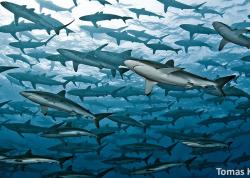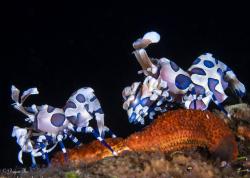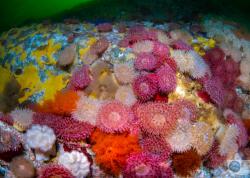5 Reasons to Dive Malapascua
5 Reasons to Dive Malapascua
A Dive Destination that Blends the Exotic with the Smallest
Text and Photos By Jeff Milisen

Malapascua Island lies in the middle of the Philippines - nowhere near anyplace I had ever heard of. After landing on the island of Cebu, blips of groggy traveling memories include a spirited 3-hour taxi ride spent at 80 km/hr mostly playing chicken with oncoming buses. After stopping to ask for directions 3 times, the driver eventually dumped us off at a dockyard where we boarded a ferry to Malapascua. The ferry is a traditional Filipino boat called a “bangka.”
After 12 hours winding our way through the country, this hilariously kludged canoe is where the Philippines started to make sense. The ingenious construction that goes into these unique boats is pure genius. Fibrous lashings hold the outriggers and much of the framework in place. The pull-started diesel engine (yes, you read that right) is generally lifted from the most recent truck that has broken down, which means the drive shaft coming out of the engine is unique to that specific boat. So to seal the driveshaft in the hull, the Filipinos use a common and easy-to-replace material - bamboo. When hollowed out, soaked with water and jammed into place, it makes a nearly perfect, watertight seal.
See also: The 8 Best Places to Dive in the Philippines
There aren’t any cars on Malapascua, so the bangka drops you off on the beach directly in front of your hotel. Our hotel was the unpretentious gem of Malapascua Island - the Hippocampus Resort. An army of helpers greeted us and helped porter our bags up the sand and straight to our room. The well-kept beachfront grounds, friendly wait staff and fresh mango smoothies confirmed that we were in the right place. The resort is designed to serve two specific kinds of guest. Some visitors come here to enjoy the idyllic island atmosphere. For them, the resort sports beautiful beach access and a top-notch restaurant (Magellan’s) that serves a delicious fusion of European and Filipino tastes. Divers, on the other hand, flock here from all over the world to see Malapascua’s most famous visitor, the thresher shark.
What most diving visitors don’t realize is that Malapascua is situated in the heart of the Coral Triangle. The funny-looking sharks with long tails may be the stars of the show, but stick around because the encore should not be missed.

Bangkas lit by a full moon on Malapascua Island.
Nudibranchs
It might seem strange to come to the only place in the world where you can reliably see thresher sharks to go nudibranch hunting, but sea slugs are literally everywhere you look! A keen eye will quickly find gloomy Thuridilla lineolata, Dorids and a small army of other species. For the thickest nudi action around, check out the crevices on Deep Rock.

You could spend all your time photographing the nudibranchs at Malapascua.
Seahorses
The animal for which our resort took its namesake (Hippocampus) is certainly one of the island’s most memorable residents. Aside from having a completely backwards reproductive strategy, where the male hatches the eggs, seahorses look gangly and certainly aren’t the quickest fish in the sea. Watching them stumble around in aquariums, it is a wonder that seahorses haven’t been devoured out of existence by every hungry reef predator alive. Then I tried finding one in Malapascua. It really doesn’t matter what species you are looking for; a seahorse’s camouflage is nearly perfect. We had them on muck dives, on reef dives, and they even popped out on the mandarinfish night dive. Of course, the star seahorse, the pygmy, is best known for its ability to blend in with gorgonians. At Deep Rock, our guide, who had eyes like a hawk, spotted a pygmy seahorse on a sea fan. While lining up the next shot, I lost sight of the tiny, mostly immobile animal and spent the next 3 minutes searching the tiny area before finding it again!

Pygmy seahorses are well-camouflaged on their host sea fans.
House Reef
This is the catchall for the rest of the macro life you might encounter in Malapascua. Sandy environments aren’t generally synonymous with biodiversity, unless you are in the Coral Triangle. Creatures just crawl out of nowhere, and in varieties I was not prepared for. SeaQuest’s House Reef, for example, is simply a sandy flat where somebody sank a bangka a few years ago. But the life that you can find in such a simple environment like sand is astonishing! The Indian Walkman, for example, looks like a scorpionfish that wanted to dress like a leaf with thorns. And it is always covered in sand. It just looks like an amalgamation of strange. The challenge in photographing something that wild is choosing a body part to focus on. Also watch for blue-ringed octopus, frogfish, sea moths, sea snakes, and just about anything else that lives underwater.

This crinoid shrimp as turned yellow to match its host.

A blue-ringed octopus greets us at the house reef.
Mandarinfish
Every evening, an adorably amorous species of dragonet goes off in search of a mate. Like clockwork, the colorful fish find a special friend, and just as the sun is setting, take part in a spectacular little dance. At first they greet and start swimming around each other, slowly rising up from the reef. Once at their apex, they cuddle and spawn gametes into the water. The mandarinfish at Lighthouse Reef in Malapascua are especially large and abundant. Attentive photographers can nail the split second of spawn by following directions closely. First, find a pair and stick with them. Second, don’t use any light unless it is red. This makes focusing a challenge, but the little fish can get distracted out of their nightly ritual. Finally, wait for the fish to start swimming circles and rise up from the reef. Four seconds later, they spawn and dart back to their hiding spot in the coral.

Two mandarinfish at the peak of their nightly ritual.
Threshers
No article on Malapascua would be complete without the mention of its most famous inhabitant - the threshers of Monad Shoal. The animals come from pelagic water in the early morning hours to visit the cleaning stations on one side of the shoal. They have been around enough divers that they are no longer afraid of the observers and come in quite close. Plan to spend a couple of mornings at Monad. Our first attempt was canceled due to weather, and our second was the first no-show they had seen in months. On day three, however, we had two threshers show up and put on one heck of a show.

A thresher shark swims by - the icon of Malapascua.
For the average westerner, the road to Malapascua is long and arduous, fraught with cultural challenges you may never see again. But this lonely island just off Cebu’s coast is inhabited by friendly people, fringed by an idyllic beach and surrounded by some of the best diving on the planet. It used to be on my bucket list, and now that I have been there/done that, I am already planning to return.
Want to Dive Malapascua?
Visit Bluewater Travel's Malapascua Dive Trip page to learn more.
Also by Jeff Milisen
-
The Ultimate Guide to Sea Turtle Photography
-
An Inside Look at Hawaii's Best Dive Sites
-
Putting Kosrae on the Map
-
The Two Faces of Dumaguette
About the Author
Jeff Milisen is a relatively new content writer for the Underwater Photography Guide who specializes in black water and big animals. When not behind a camera, Jeff is a marine biologist working to reduce overfishing by improving methods for farming fish. Milisenphotography.yolasite.com
Support the Underwater Photography Guide:
The Best Service & Prices on u/w Photo Gear
 Visit Bluewater Photo & Video for all your underwater photography and video gear. Click, or call the team at (310) 633-5052 for expert advice!
Visit Bluewater Photo & Video for all your underwater photography and video gear. Click, or call the team at (310) 633-5052 for expert advice!
The Best Pricing, Service & Expert Advice to Book your Dive Trips
 Bluewater Travel is your full-service scuba travel agency. Let our expert advisers plan and book your next dive vacation. Run by divers, for divers.
Bluewater Travel is your full-service scuba travel agency. Let our expert advisers plan and book your next dive vacation. Run by divers, for divers.
RECOMMENDED ARTICLES
SUPPORT THE UNDERWATER PHOTOGRAPHY GUIDE:
The Best Service & Prices on u/w Photo Gear
 Visit Bluewater Photo & Video for all your underwater photography and video gear. Click, or call the team at (310) 633-5052 for expert advice!
Visit Bluewater Photo & Video for all your underwater photography and video gear. Click, or call the team at (310) 633-5052 for expert advice!
The Best Pricing, Service & Expert Advice to Book your Dive Trips
 Bluewater Travel is your full-service scuba travel agency. Let our expert advisers plan and book your next dive vacation. Run by divers, for divers.
Bluewater Travel is your full-service scuba travel agency. Let our expert advisers plan and book your next dive vacation. Run by divers, for divers.































